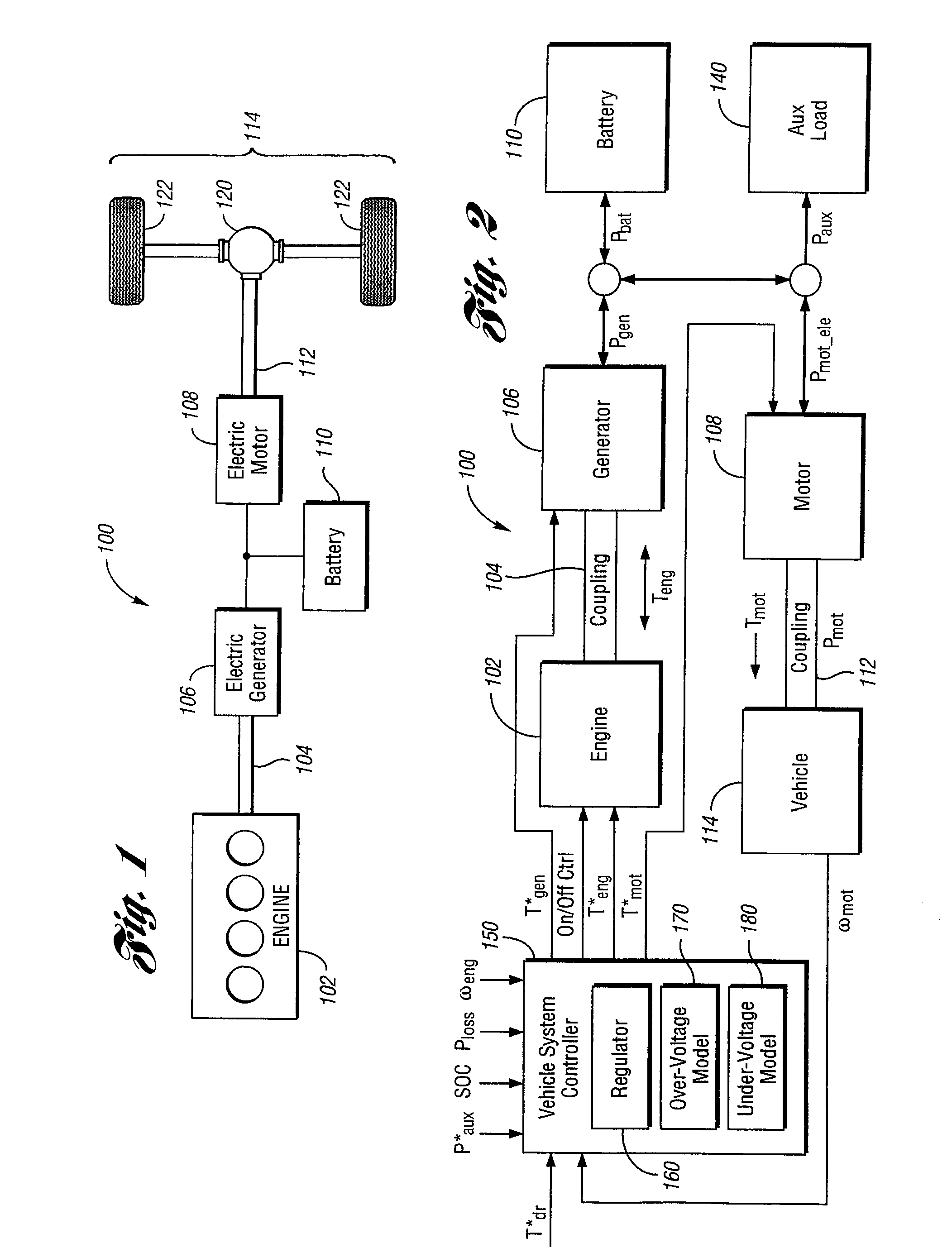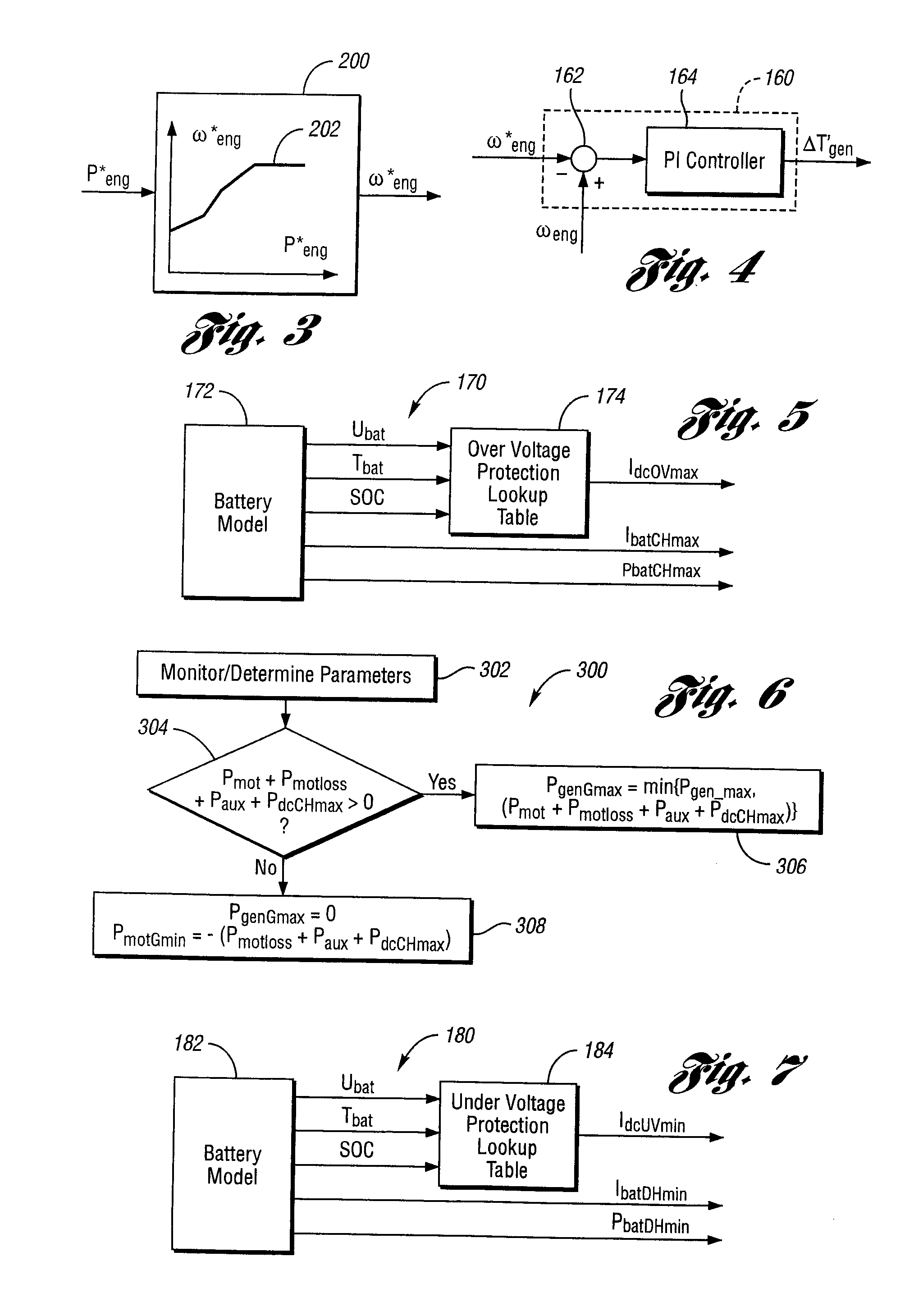[0009] A hybrid
electric vehicle (HEV) system and method is disclosed that substantially overcomes the limitations and shortcomings of conventional HEV control systems and methods. In accordance with one embodiment of the present invention, a method for controlling a
hybrid powertrain system for an automotive vehicle operated by a user is provided. The system has an engine, an electric
machine that performs as a motor in one mode of operation and performs as a generator in another mode of operation, a battery connected to the electric
machine, and a generator configured to receive mechanical power from the engine and to present electrical power to at least one of the electric machine and the battery, and at least one of the engine and the electric machine establish a power source for providing power to vehicle traction wheels. The method includes the steps of determining a first power state of the
hybrid powertrain system, limiting electrical power generated by the generator to the minimum of the rated power limit of the generator and the first power state, when the first power state is greater than zero, and limiting the electrical power generated by the generator to zero, and limiting the power limit of the electric machine during generating to a first operating condition of the
hybrid powertrain system, when the first power state is less than or equal to zero, to provide over-charge protection to the battery.
[0010] Further, when engine start is of higher priority to the user than drive performance, the method can include the steps of limiting the power limit of the electric machine during motoring to the minimum of the rated power limit of the electric machine, and the negative of a second operating condition of the hybrid powertrain system, when the second operating condition is less than zero, determining when a third operating condition of the hybrid powertrain system is less than zero, when the second operating condition is equal to or greater than zero, limiting the auxiliary loads to the minimum power for maintaining the vehicle operation, and limiting the power limit of the electric machine during motoring to the minimum of the rated power limit of the electric machine and the negative of the third operating condition, when the third operating condition is less than zero, and adjusting an engine start strategy to provide earlier starting of the engine, when both the second and the third operating conditions are equal to or greater than zero, to provide over-
discharge protection to the battery.
[0011] Yet further, when drive performance is of higher priority to the user than engine start, the method can include the steps of limiting the electrical power of the generator during motoring to the maximum of the negative of the rated power limit of the generator, and a fourth operating condition of the hybrid powertrain system, when the fourth operating condition is less than zero, determining when a fifth operating condition of the hybrid powertrain system is less than zero, when the fourth operating condition is equal to or greater than zero, limiting the actual total power consumed by the auxiliary loads to the minimum auxiliary power requested, and limiting the electrical power of the generator during motoring to the maximum of the negative of the rated power limit of the generator and the fifth operating condition, when the fifth operating condition is less than zero, and adjusting an engine start strategy to provide earlier starting of the engine, when the fifth operating condition is equal to or greater than zero, to provide over-discharge protection to the battery.
[0012] The present invention generally provides a
robust control system for reducing or preventing a hybrid
electric vehicle (HEV)
electric power storage device (e.g., battery) from at least one of over charging and over discharging. The present invention will generally prolong battery life and reduce or prevent the vehicle from having quit on road (QOR) conditions due to battery over limit conditions.
[0013] The present invention generally provides a strategy for determining the hybrid electric vehicle generator and
motor power limits under different operating (e.g., driving, idling, etc.) conditions. Operation of the generator and motor within the generator and
motor power limits will generally prevent the battery from over power / current and from under / over
voltage during either charging or discharging and hence will reduce or eliminate the QOR due to over-charge and over-discharge of the battery.
 Login to View More
Login to View More  Login to View More
Login to View More 


